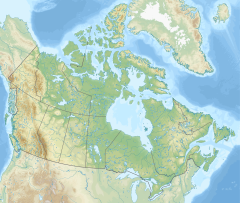| Kazan River | |
|---|---|
 Kazan Falls, on the lower Kazan River | |
| Location | |
| Country | Canada |
| Physical characteristics | |
| Source | Kasba Lake |
| • location | Northwest Territories |
| • coordinates | 60°34′22″N 102°08′47″W / 60.57278°N 102.14639°W |
| Mouth | Baker Lake |
• location | near Chesterfield Inlet, Kivalliq Region, Nunavut |
• coordinates | 64°2′30″N 95°29′5″W / 64.04167°N 95.48472°W |
• elevation | 2 m (6 ft 7 in) |
| Length | 1,000 km (620 mi) |
| Basin size | 71,500 km2 (27,600 sq mi) |
| [1][2] | |
The Kazan River (Inuktitut Harvaqtuuq,[3] Inuktitut syllabics ᓴᕐᕙᖅᑑᖅ;[4] meaning "strong rapids",[5] "the big drift"[3] or "place of much fast flowing water"[4]), is a Canadian Heritage River located in Nunavut, Canada. The Dene name for the river was Kasba-tue meaning "white partridge river." The name was apparently changed to Kazan in the late 19th century due to the influence of Order of Mary Immaculate missionaries.[6] The river headwaters are in northern Saskatchewan[7] at Kasba Lake, and it flows north for about 1,000 kilometres (620 mi)[7] before emptying into Baker Lake (64°09′00″N 95°30′00″W / 64.15000°N 95.50000°W), on the opposite side of the mouth of the Thelon River. Along its course the river flows through several lakes, including Ennadai Lake and Yathkyed Lake, over the Kazan Falls (25 metres (82 ft)), down a red sandstone gorge[7] and through both boreal forest and tundra. It is the last section of the river, below Ennadai Lake, that is above the timber line and is designated a Canadian Heritage River.
- ^ "Natural Resources Canada-Canadian Geographical Names (Kazan River)". Retrieved 29 August 2014.
- ^ "Atlas of Canada Toporama". Retrieved 29 August 2014.
- ^ a b Harvaqtuurmiut : The Heritage of the Inuit of the Lower Kazan River
- ^ a b Kitikmeot Heritage Centre
- ^ Tuhaalruuqtut, Ancestral Sounds
- ^ Sikstrom, C. B. (10 December 2012). "The Naming of Kazan River, Nunavut, Canada". Arctic. 65 (4): 433–438. doi:10.14430/arctic4241. ISSN 1923-1245. Archived from the original on 2 June 2018. Retrieved 20 April 2016.
- ^ a b c "Nunavut: Heritage Rivers" Archived 2013-01-21 at the Wayback Machine The Atlas of Canada

